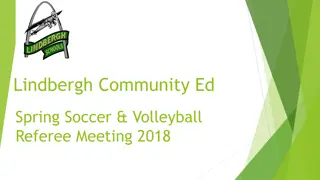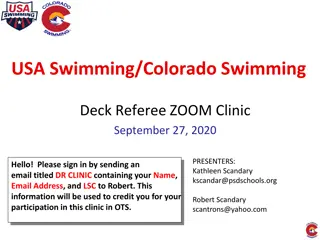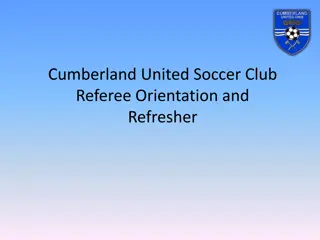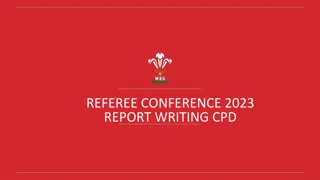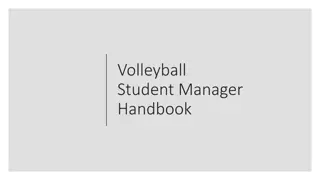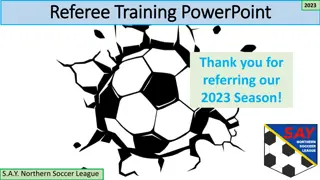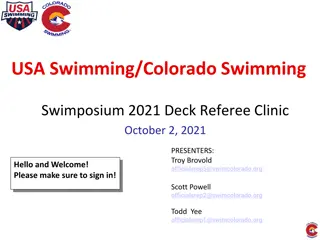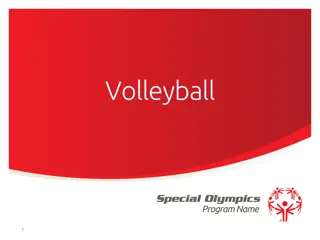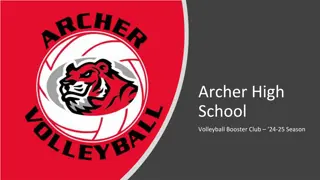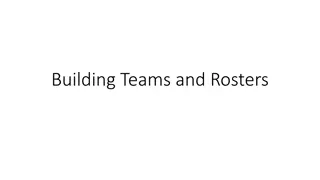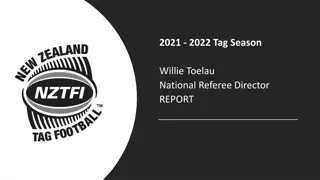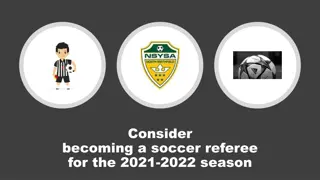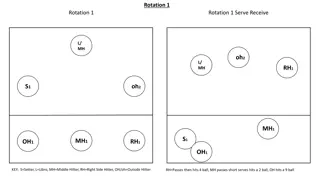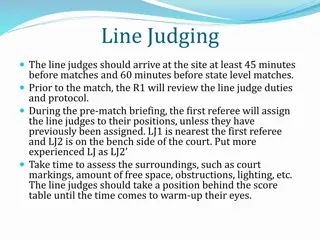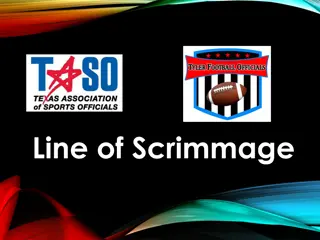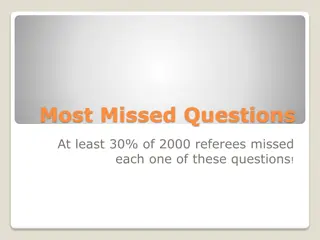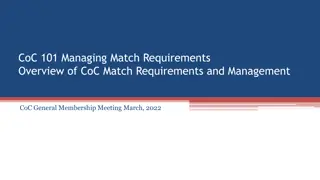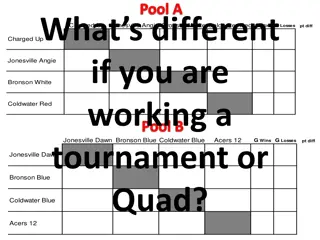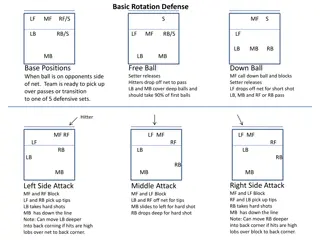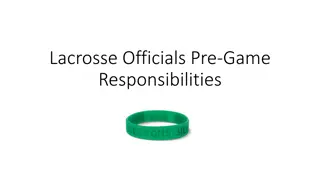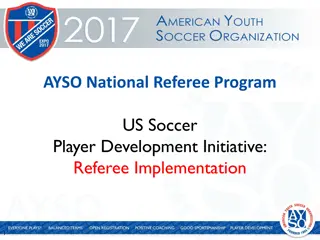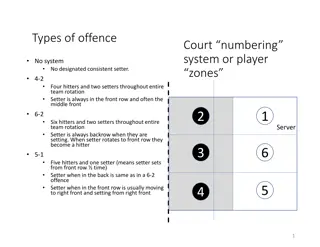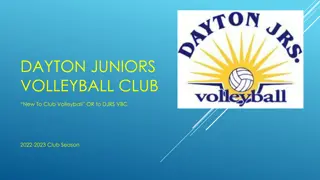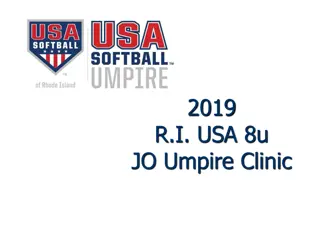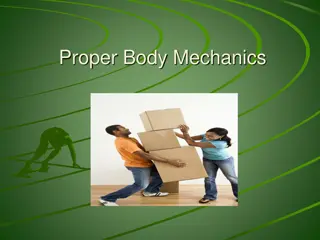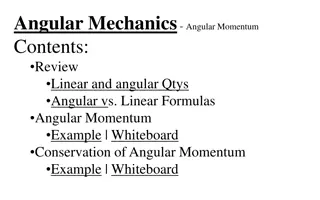Volleyball Referee Pre-Match Responsibilities and Mechanics Guide
In this comprehensive guide for volleyball referees, learn about the pre-match responsibilities and mechanics of the R1 (first referee). From meeting with the R2 to checking special ground rules, addressing unusual court markings, and ensuring safety measures, this guide covers key aspects to be aware of before and during a match. Additionally, details on coordinating with the R2, observing warm-ups, and signaling during the match are included for a better understanding of the roles and responsibilities of a volleyball referee.
Download Presentation

Please find below an Image/Link to download the presentation.
The content on the website is provided AS IS for your information and personal use only. It may not be sold, licensed, or shared on other websites without obtaining consent from the author. Download presentation by click this link. If you encounter any issues during the download, it is possible that the publisher has removed the file from their server.
E N D
Presentation Transcript
SERVING AS THE R1 THE FIRST REFEREE Summer 2022
PRE-MATCH AS THE R1 1. If possible, meet with your R2 before the match. Enter the gymnasium together if possible. 2. Locate event management, introduce yourself and find out where they will be during the match in the event that you need their assistance due to injuries, disruptive fans, and/or participants. 3. With your R2, check the gymnasium for any special ground rules that you might need to apply to the match (overhead obstructions, unplayable areas, handicap or wheelchair areas, etc.)
PRE-MATCH AS THE R1 SPECIAL GROUND RULES TO BE ADDRESSED 1. Baskets hanging over a playable area a) Vertical baskets are a dead ball with a possible replay to be awarded. A basket is deemed to be vertical if it is in the position that it needs to be in order to play basketball. If it is not down in the basketball playable position, it is considered ceiling. Wall mounted baskets that extend out over a playable area are dead ball and judgement as to replay or not. 2. Indentation or alcoves beside the bleachers a) Any area where the official cannot see the player when playing the ball is considered unplayable space and should be called a ball out. 3. Any unusual or abnormal markings on the court should be addressed. 4. Tournament situations may change some of these ground rules.
PRE-MATCH RESPONSIBILITIES OF THE R1 1. Check the height of the net. If it works best to have the R2 help with this, that is totally acceptable. Be sure that all exposed metal (chains, cables or hooks) are covered with padding for safety. 2. Check the ladder that you will be standing on as the R1. Be sure it is positioned or fastened to the net properly. Also check to be sure that there is proper padding on the stand as all metal surfaces should be covered. 3. Check with the Home team to see if they will be using shaggers for their match.
MECHANICS WITH YOUR R2 Pre-Match Observe warm-ups together and discuss how you will communicate with each other. This could be different with different partners. Look for Libero together and identify legality of the jersey, etc. Check with coach if you have questions regarding legality. Is there anything that either of you are working on that you might need help from each other?
MECHANICS WITH YOUR R2 During the Match Signals that the R1 mimics from the R2. Substitution Net violation R2 blows whistle, steps to side of violation, signals net, and then both R2 and R1 signal side out together. The R1 does not mimic the net signal or the center line violation as called by the R2, just side out part. The R1 also does not mimic calls that are initiated by the R2. Time Out signal
MECHANICS WITH YOUR R2 During the Match Discreet signals Calling the game to tight or too loose? Front row or back row? (When the R1 loses track) Rotation? Calling the R2 over to your stand. (Call the LJs if necessary).
MECHANICS WITH YOUR R2 After the Match If this match has potential to be intense, during the pre-match the R1 can ask the R2 to grab their bag from the scorer s table after the match and scoot quickly to the previously designated officials area.
TIME AND COURT MANAGEMENT Divided into 3 Phases 1. Setting up the Match 2. The Match Itself 3. After the Match
SETTING UP THE MATCH THE CAPTAIN S MEETING After determining if the Home team will be using ball shaggers or not, remind the players of the process. If no shaggers, let the players know that Lines Judges will not be involved in retrieving shanked balls and this will be their responsibility. Emphasize to the captains that all shanked balls must be retrieved prior to their team huddles between rallies. Remind them that they must tell their teammates. Be sure to confirm with the coaches that their players are legally attired and equipped. Review the special ground rules you identified earlier. Remind the coaches that their line-ups are due at the 2 minute mark on the warm-up clock.
SETTING UP THE MATCH MEETING WITH YOUR LINE JUDGES This task should be done away from public view, possibly in the hall or off the end of the court beside the bleachers. You can assign the line judges to a specific corner or let them choose. Go over what you expect from them (eye contact, etc.) Ask your line judges to keep an eye out for any volleyballs coming from another court. (This should not interfere with their duties during play on their own court). Let them know they play an integral part in keeping the game moving. Remind your LJs that they must wear appropriate footwear for safety.
SETTING UP THE MATCH MEETING WITH THE SCORERS TABLE Find and introduce yourself to the announcer at the scorer s table. (By asking them what the last thing they are going to say before the match begins, you will be prepared to blow your whistle and release the players from the endline and into greeting of the opposing team.) Inform announcer that once the beckon for serve has been initiated, speaking and music must be stopped. Inform the scoreboard operator and scorekeeper to wait and follow your signal for points before they change the score. This is important because sometimes the person operating the electronic or manual scoreboard will react as soon as the play ends and aware a point to the wrong team. Most importantly, stress no cell phones can be used at the table while the match is in play. This can seriously disrupt the flow of the match and is a near certainty that a mistake will occur.
SETTING UP THE MATCH TAKING YOUR PLACE ON THE COURT Once the warm-ups have completed, it is time to get started. LJ1 and R1 should respectfully acknowledge each other with a handshake, first pump, or nod with the LJ2 and R2 and then cross the court and stand on the right side of the court (as you face the table) with R1 closer to the net than the LJ. The LJ1 should place their flag on the R1 stand prior to the National Anthem and introductions. After the playing of the National Anthem and the introduction of players, the R1 should blow their whistle and indicate for the players to leave the end line and meet at centerline by using whichever greeting is customary for that league. The LJ1 can now grab their flag and go to their corner. The R1 should now take their place on the officials stand and wait for the R2 to complete their line-up check and get control of the court back to them.
THE MATCH R1 should scan the court Receiving team LJ Receiving team bench R2 Serving team bench Serving team LJ R2 one more quick time Ensuring that everyone is ready, you can now beckon for serve. These are 3 distinct and separate functions; Extend your arm out to your side parallel to the floor, shoulder height with your palm open and forward and thumb tucked down to your hand. Blow your whistle if the server has a ball and is in the service zone. Pull your arm across your chest and touch your fingers to the opposite shoulder. The beckon for serve is deemed to have been completed when you blow your whistle. No requests for game interruptions may occur after the whistle has blown.
THE MATCH As the first referee, within the first five to six points of the match, you need to establish the pace of the game. Prior to the server receiving the ball, check the scoreboard, check with your R2, check for substitutions or time outs, scan the court and be ready to whistle and beckon for serve. As soon as the server has the ball and looks towards the court, beckon for serve. Once you set the pace, the players will adjust with their substitution rotations and serving patterns. When it s a tight game or a team is getting defeated badly early in the game, anticipate time-out requests. If the game is in the 20s for both teams, you should expect time-outs coming from both coaches. Maintain frequent eye contact with your line judges. If they re doing a great job, give them an occasional thumbs up or appraisal when on your side of the court during a time out. However, if they are not paying attention, you may want to put a little emphasis on their performance when they make a great call. Either way, keep them involved. Keep an eye on your coaches for extended time outs or unnecessary delays. Between your R2 and yourself, don t be afraid to give that courtesy warning, and if it continues, an unnecessary delay will be assessed.
THE MATCH CALLS MADE BY THE R1 Serving errors Offensive alignment Ball handling Touch, In and Out Calls Sanctions CALLS MADE BY THE R2 Defensive alignment Net violations Center line violations Help with touch, in and out calls if needed Ball handling (discreet signal to R1) if R1 is blocked from call R1 WHISTLES VIOLATION AFTER R2 HAS BEEN GIVEN FIRST PRIORITY Center line violations Net violations
AFTER THE MATCH Some coaches and players may thank you, but keep it brief so that you can move on to the next match. You will always encounter some match delays that cannot be prevented such as injuries, equipment/court malfunctions, protests, etc. Be supportive of the R2 as they work through these situations. Provide assistance if needed. Just remember: Check the scoreboard, check with your R2, check for substitutions, scan the court, locate the ball, recognize the server, beckon for serve and keep the game moving. A post-match debriefing should happen after each match. These are to be held with all members of your crew and are meant for learning opportunities for all, not criticism or demeaning. All members of the crew should feel free to give and accept constructive comments and suggestions. Wait for your fellow officials before leaving the facility, especially if there was any conflict in the match.
BETTER OFFICIATING TIPS FOR THE R1 A strong whistle exudes confidence in your call. It gets the players attention, stops play and shows you are in control of the match. Your whistle tone and volume should coincide with the size of the venue you are working and the amount of noise in the facility. Before you beckon for serve, do a thorough scan of the entire court to ensure that your crew is ready, check that there are six players for each team on the court and that the server has the ball. If both teams appear to be ready, and the server is in possession of the ball in the service zone behind the end line, it is not necessary for the first referee to wait for the server to go through his or her pre-serve routine or to get into optimal position before authorizing the serve. Keeping a consistent tempo benefits all match participants.
BETTER OFFICIATING TIPS FOR THE R1 Just because ball handling looks bad does not mean it is illegal. You are going to see all types of skills and techniques when it comes to ball handling. Don t judge what is legal or illegal by appearances alone. Some legal sets can result in the ball spinning. Avoid making rulings based off the reactions of the crowd or coach. You might be the only person in the gym who had a clear view of a pancake play or a net fault. As soon as you let a coach or crowd reaction sway your rulings, you are no longer in control of the match. They are. An important component of developing good ball handling judgement is to get your eyes ahead of the ball and focus on each contact of the ball with the hands or body. Only the contact point should be considered when judging legality. Outside influences such as spin or player technique should not affect your judgement.
BETTER OFFICIATING TIPS FOR THE R1 Whether a completed attack is executed with an open or closed hand, fingertips, forearm, dump or even with a foot or head, your standards for ruling on that attack should not change. If there is no prolonged contact or illegal multiple contacts, play should be allowed to continue. It is critical that the referees know the setter s position (front or back row) for each team before each rally begins. This could prevent an official from mistakenly calling an illegal back-row block or attack, which could then result in a replay.
BETTER OFFICIATING TIPS FOR THE R1 If you make a questionable call during a match, forget about it for the moment. If you let it eat at you, you won t be thinking about the next play and you may miss that one as well. The time to reflect on your mistakes and examine your performance is after the match. If there is a possibility that a ball may have passed outside or over the antennae or contacted it, quickly look for information/signals from the line judges using your peripheral vision as play continues. If you are not sure and your line judges are not giving you information, do not make the call. When the first referee overrules a line judge s call, be prepared to explain the decision to the captain of the team that lost the point. Players and coaches will likely point out the line judge s original call. Explain to them that the first referee can overrule a call made by another member of the officiating crew. Be sure to tap on your chest indicating that YOU are the one that made that call.
BETTER OFFICIATING TIPS FOR THE R1 Use team captains to convey messages about minor behavioral problems before issuing a sanction. When possible, address minor problems by beckoning the captain to the referee stand and having a conversation with him or her. Take one or two steps down to bring yourself to the eye level of the player/captain. Deal with players and coaches respectfully and honestly. Avoid becoming confrontational. Try to remain conversational during heated moments, even if the other party is trying to amplify things. However, if the behavior rises to a level where you must take corrective actions, do not be afraid to use the tools at your disposal (warning, penalty or disqualification). Often a short toot-toot and eye contact will let the person involved know that their action is not acceptable.
PROFESSIONALISM The first referee orchestrates the match, but it is important for both the R1 and the R2 to work together in their pre-match discussion and then have good communication to get the calls right during the match. Was the ball in the tape, or was it four hits? Was the setter in the back row and reaching above the net to play the ball back? Provide help. If the call is close and questionable this is a good time to indicate that the ball was in the plain of the net. Given the palm out facing down signal to indicate. Did the ball cross over the outside center line when behind the R1 or the R2? Preventive officiating goes a long way in gaining respect and trust from your coaches and players. You have officiated a good match if you can leave the court without anyone knowing you were there. Do not insert yourself into the match unless absolutely necessary.
THANK YOU FOR LEARNING! Kelli Hart Capital Area Association of Volleyball Officials


